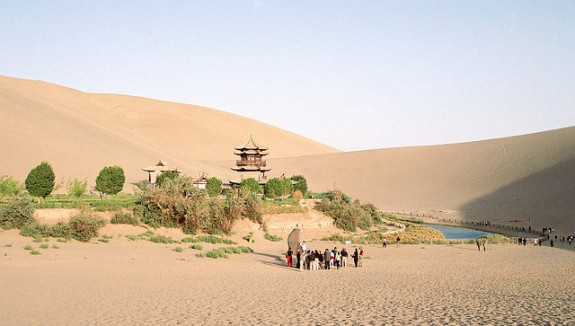
Tourists explore the Crescent Moon Spring along the historic Silk Road trade route. Photo: Wo Shing Au
A few years ago, the University of Washington’s John E. Hill drafted an English copy of the Weilüe, a third century C.E. account of the interactions between the Romans and the Chinese, as told from the perspective of ancient China. “Although the Weilue was never classed among the official or ‘canonical’ histories, it has always been held in the highest regard by Chinese scholars as a unique and precious source of historical and geographical information,” says Hill.
The translated text gives a curious look at the way of life of third century Rome, a land ruled by “numerous minor kings.” The chronicle even comes with extensive directions on how to get there—go across the Indian Ocean, cut up to Egypt, duck through the Nile, sail across the Mediterranean (about six days) until you find yourself in Da Qin, the Roman Empire.
The text describes the organization of Roman society, and a list of the products they had on offer.
This country (the Roman Empire) has more than four hundred smaller cities and towns. It extends several thousand li in all directions. The king has his capital (that is, the city of Rome) close to the mouth of a river (the Tiber). The outer walls of the city are made of stone.Apparently, according to Yu Huan, the author of the Weilue, getting around ancient Rome was pretty dangerous:
…The ruler of this country is not permanent. When disasters result from unusual phenomena, they unceremoniously replace him, installing a virtuous man as king, and release the old king, who does not dare show resentment.
The common people are tall and virtuous like the Chinese, but wear hu (‘Western’) clothes. They say they originally came from China, but left it.
They have always wanted to communicate with China but, Anxi (Parthia), jealous of their profits, would not allow them to pass (through to China).
The people (of these countries) are connected to each other. Every 10 li (4.2 km) there is a ting (relay shed or changing place), and every 30 li (12.5 km) there is a zhi (postal station). There are no bandits or thieves, but there are fierce tigers and lions that kill those travelling on the route. If you are not in a group, you cannot get through.This was not the first translation of the Weilue, says Hill. The section on the Romans was previously translated back in 1885, with other sections coming after.
More from Smithsonian.com:
Demolishing Kashgar’s History
Ancient Rome’s Forgotten Paradise
No comments:
Post a Comment